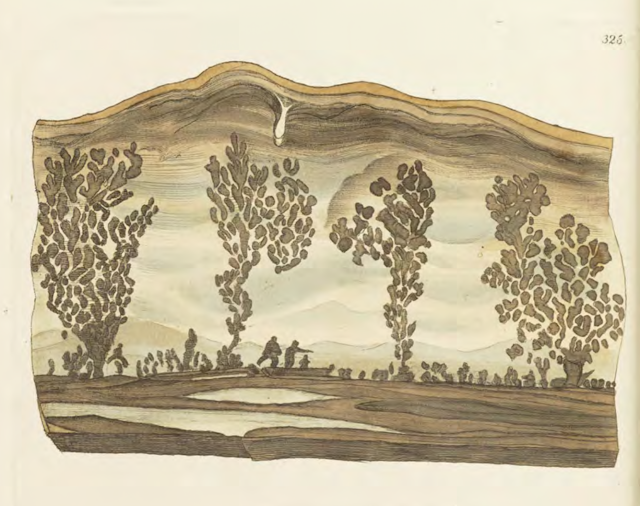A 19th century specimen of Cotham Marble, a Triassic microbialite
Cotham Marble from near Bristol is far from uncommon, but old museum specimens of the material are rarely seen. One such 19th century specimen is illustrated below. The chain of ownership runs from John I. Legro (1842-1923) to Hugh A. Ford (1885-1966) to Eugene Carmichael and the A.E. Seaman Mineral Museum (named for professor Arthur Edmund Seaman, 1858-1937).
Sowerby (1811, p. 41) illustrated a similar polished slab of Cotham Marble (his TAB. CCCXXV), shown below.
He wrote,
'Cotham, near Bristol, affords this remarkably figured Marle, which, according to the Bristol Guide, you may often imagine is a fine drawing. It is a curious formation of Marle and Clay, chiefly stained by Iron, and perhaps occasionally by Manganese, forming, by settling moisture under peculiar circumstances, the top undulations, sometimes representing clouds in a sky, while the bottom imitates earth and water as in landscapes. The fanciful figure to themselves in this something like a boat and men in one part, and hedge-rows in another, with trees in full foliage. The appearance of the different parts seems in a great measure to point out the different substances. The whiter part is softer, and has most Lime; the bluer or grayer have a dilute mixture of the black Oxide of Iron; the browner part being still harder in consequence of the state of the Oxide of Iron, and the quantity of Clay or Alumine; forit must be remembered that Clay often has much Silex mixed with it. The deposition indicates the mass to have been more fluid in some parts than in others; and perhaps some conjecture might be formed as to the trees having distilled in drops from the upper waved surface; but at present we must rest with the theory, the practice of which may lead to useful and certain truths. This substance is found in broad slabs, and is cut transversely from the thickness of an inch to a foot or more. It is sometimes admired for ornamental chimneypieces, and the masons in the neighbourhood have used a great deal of it for such purposes.'
Sowerby did not know how to interpret these uppermost Triassic microbial structures and had focussed on the descriptive aspects. Mayall & Wright (2015) describe the Cotham Marble as a microbialite with the main topography of the mounds constructed by an intimate association of Microtubus communis and laminar stromatolite. Ibarra & Corsetti (2016) noted that the microbialites 'occur as meter-scale mounds and contain a characteristic succession of laminated and dendrolitic mesofabrics. The same succession of laminated/dendrolitic couplets can be traced, not only from mound to mound, but over 100 km, indicating a regional-scale influence on very small structures (microns to centimeters) ..'
The 'Cotham Marble' is both decoratively interesting and geologically fascinating. In addition, the long succession of owners in this case make the piece a cultural relic as well as a geological specimen.
References
Ibarra, Y. & Corsetti, F.A. 2016. Lateral Comparative Investigation of Stromatolites: Astrobiological Implications and Assessment of Scales of Control. Astrobiology, 16, 1-11.
Mayall, M.J. & Wright, V.P. (2015). Comment to Ibarra et al. microfacies of the Cotham Marble: A tubestone microbialite from the Upper Triassic, southwestern U.K. Palaios,
Sowerby, J. 1811. British Mineralogy, volume IV, Richard Taylor and Co, London, 184 pp.






Comments
Post a Comment